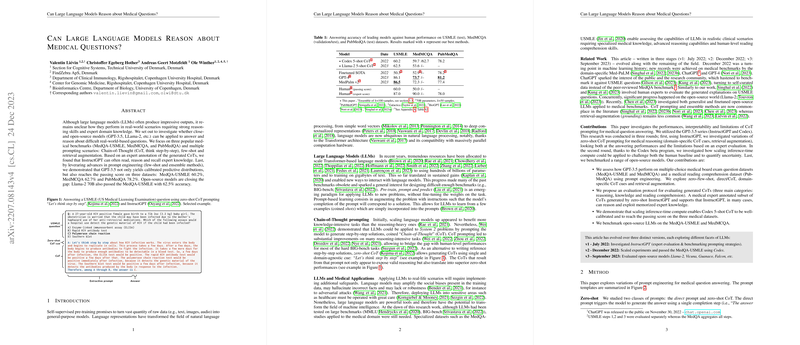Can LLMs Reason about Medical Questions?
The paper "Can LLMs Reason about Medical Questions?" investigates the capabilities of LLMs, such as GPT-3.5 and LLama-2, in tackling medical question answering tasks. The research focuses on evaluating the reasoning abilities of these models through popular medical benchmarks like MedQA-USMLE, MedMCQA, and PubMedQA. This work explores various prompting techniques, including Chain-of-Thought (CoT) prompting, few-shot, and retrieval augmentation, assessing both the interpretability and performance of generated outputs.
Research Objectives and Methods
The primary aim of this paper is to determine whether LLMs can handle complex medical scenarios requiring specialized knowledge and reasoning skills. The paper examines closed-source models like GPT-3.5 and open-source models such as LLama-2, utilizing different prompting strategies:
- Chain-of-Thought (CoT) Prompting: Encourages step-by-step reasoning, allowing models to generate structured explanations.
- Few-Shot Learning: Involves providing a few examples within prompts to guide the model.
- Retrieval Augmentation: Leverages external knowledge bases to augment the model's memory and reasoning process.
The researchers conducted experiments across three datasets, benchmarking the models against human performance baselines and fine-tuned BERT models.
Key Findings
- Performance on Benchmarks: GPT-3.5 achieved notable results, surpassing human passing scores on MedQA-USMLE (60.2%), MedMCQA (62.7%), and PubMedQA (78.2%). The open-source LLama-2 (70B) model also demonstrated strong performance, achieving a 62.5% accuracy on the MedQA-USMLE.
- Quality of Reasoning: Expert evaluations of the outputs revealed that models like InstructGPT often could read, reason, and recall expert knowledge, albeit with occasional errors in reasoning or knowledge recall.
- Effectiveness of Prompting Techniques: Zero-shot and few-shot CoT prompting proved effective in yielding interpretable outputs, with ensemble methods further enhancing performance through self-consistency.
- Comparison with Human Expert Scores: Although LLMs approached human-level passing scores, a significant gap remains when compared to human expert scores, indicating room for further advancement.
Implications and Speculations
The research highlights the potential of LLMs in medical fields, demonstrating their ability to process and reason about intricate domain-specific questions. However, the authors caution against deploying these models in critical real-world applications without proper safeguards due to potential biases and the risk of hallucination.
Future work could explore integrating more sophisticated retrieval methods or incorporating adversarial training techniques to improve robustness and reduce biases. Additionally, fine-tuning LLMs on domain-specific datasets while maintaining generalization capabilities remains an open research avenue.
Conclusion
The paper underscores the evolving capabilities of LLMs in medical reasoning tasks, suggesting promising applications in automated medical diagnostics and education. Nevertheless, achieving parity with human experts in medical decision-making necessitates continued research to enhance the interpretability, reliability, and ethical alignment of these models.
